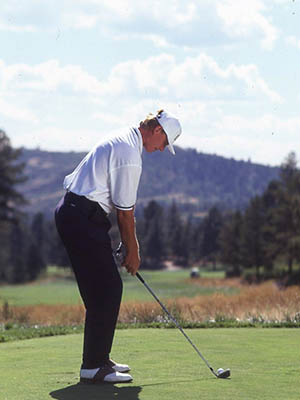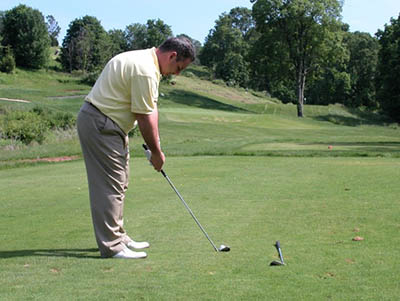Proper Golf Stance: How to Find Your Perfect Knee Flex

A Legacy Post by Keiser University College of Golf Senior Faculty and Director of Research Dr. T. J. Tomasi (1940-2023)
Knee Flex in Golf Swing
Knee flex in golf plays a crucial role in establishing a solid foundation for the golf swing. Proper knee flex allows golfers to maintain balance, stability, and power throughout the swing motion. When addressing the ball, golfers should bend their knees slightly, ensuring they are flexed but not excessively bent. This position helps to lower the body of gravity, promoting a more athletic stance and facilitating better weight transfer during the swing. Additionally, maintaining consistent knee flex throughout the swing helps to stabilize the lower body and prevent unnecessary movement, ensuring that the golfer maintains control and precision in their shot execution.
The level of knee flex can significantly impact the efficiency and effectiveness of the golf swing. Insufficient knee flex may result in limited rotation and weight transfer, losing power and distance. Conversely, excessive knee flex can restrict hip rotation and cause imbalance, resulting in inconsistencies in ball striking. Golfers should strive to find the optimal balance of knee flex that allows for smooth weight transfer, proper rotation, and a powerful, controlled swing. By understanding the importance of knee flex and incorporating it into their setup and swing mechanics, golfers can improve their overall performance and consistency on the course.
How to Perfect Your Golf Swing
Notice the word “your” in the title above; it’s there for a reason. The amount of knee flex you have at the address is determined in large part by your physique and your balance system, not by some arbitrary, one-size-fits-all standard. It’s obvious that golfers can play well at both ends of the “knee bend” continuum. Rather than copy an arbitrary standard or a particular tour player, my suggestion is that you personalize your knee flex. To find your natural balance point for knee flex, take your normal stride, allowing the right heel to rise off the ground as you plant your left foot flat on the ground. Stop at this point and check the amount of bend in your left knee. This is your optimum balance position, the one you automatically go to with each step you take. Now bring your back leg parallel to your front leg and match the amount of flex in your front knee. All you have left to do is stick your fanny out, and you should be in your perfect knee flex position. Be careful because there are extremes that you want to avoid. You don’t want to sit to the ball by over-bending your knees, because this forces you to straighten up during your downswing to avoid hitting the ball fat. Likewise, you don’t want to stand stiff-legged at address because this freezes your body out of the swing, forcing you to make a weak, handsy swing. Can you name one sport that is played stiff-legged?

Legend Ernie Els looks very comfortable with a lot of knee bend, while still maintaining a springy, athletic form.

This professional has minimal knee flex, but not zero knee flex — there is a big difference between the two.
Learn more!
Want more tips? If you want to take your game to the next level, contact our team at Keiser University’s College of Golf & Sport Management today. With our dedication and experience, we can elevate your game to new heights together. Give us a call today at 888-355-4465.















I think this is helping me with better ball contact with my irons. Thank you. I used to hit a lot of thin and fat shots. It is not mentioned enough anywhere.